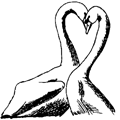Papers in the Biological Sciences

Handbook of Waterfowl Behavior by Paul A. Johnsgard
Tribe Cairinini (Perching Ducks)
Document Type Article
From Handbook of Waterfowl Behavior by Paul A. Johnsgard. Copyright © 1965 Cornell University Press; electronic edition copyright © 2008 Paul A. Johnsgard.
Abstract
Delacour and Mayr (1945) placed the perching duck tribe after the pochards (Aythyini) and adjacent to the sea ducks (Mergini), but hybridization evidence (Johnsgard, 1960a) clearly indicates that the group belongs between the shelducks and the dabbling ducks and closely adjacent to the latter. There is other evidence to support this arrangement. The tracheae of shelducks, perching ducks, and dabbling ducks are all very similar, possessing bullae which in most species are osseous and rounded, and lacking enlargements of the tracheal tube. The downy young of perching ducks and dabbling ducks are very similar, and are usually patterned with dark brown and white or yellow. Woolfenden (1 96 1) has advocated merging the perching ducks and dabbling ducks into a single tribe (Anatini), but although the two groups do tend to overlap in some of their characteristics, I believe that merging them would result in an unduly large and heterogeneous tribe. Such action would, however, resolve the problem of the tribal allocations of such species as the Brazilian teal and ringed teal. Some species of perching ducks mature in two years, although the smaller species mature their first year. Nearly all perching ducks have metallic coloration on the upper-wing surface. With few exceptions they do not dive well or frequently, and apparently all use their wings when submerging. Most of them dabble for their food, and some also graze. Nearly all species are hole-nesters, and have relatively long incubation periods. As here constituted the tribe contains thirteen species; those included in it by Delacour (1959), plus an additional species, the ringed teal (Anas leucophrys of Delacour), which is here considered to comprise a separate genus (Callonetta).

